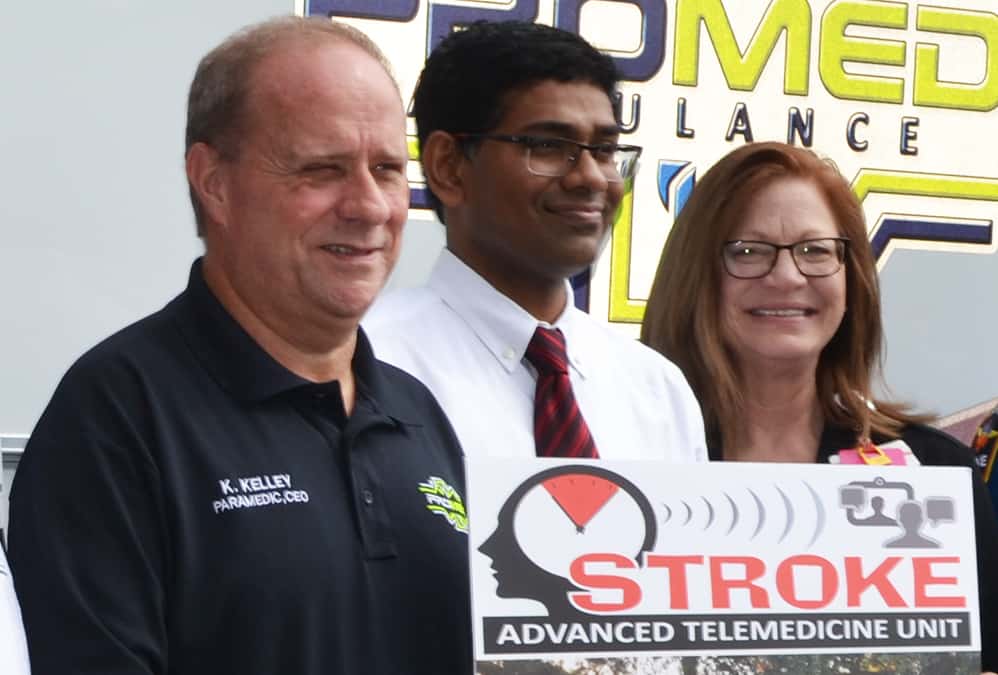UAMS-Led Stroke Program Helps Lower Arkansas to Seventh in Stroke Deaths among All States
| Arkansas recently fell from sixth to seventh place in the nation in the number of stroke deaths per capita, a huge improvement that health officials credit in part to a statewide telemedicine program of stroke education and treatment led by the University of Arkansas for Medical Sciences (UAMS).
Only four years ago, Arkansas still was ranked first in per capita stroke deaths based on data from the federal Centers for Disease Control and Prevention.
The UAMS-led Arkansas Stroke Assistance through Virtual Emergency Support (AR SAVES) program provides 54 Arkansas hospitals with round-the-clock access to stroke neurologists who can quickly assess whether a stroke patient can be helped by a clot-busting drug— alteplase — that often restores complete function to the patient. AR SAVES is a part of the UAMS Institute for Digital Health & Innovation.
“Through digital health technology at the institute, UAMS knowledge and expertise in programs like AR SAVES add value to the population in making these patient care decisions,” said UAMS Chancellor Cam Patterson, M.D., MBA. “We can improve the lives of people in ways we couldn’t before and do it wherever they are. UAMS is training the future health care work force to use digital health, and the institute is coming up with new ways of caring for patients and keeping them healthy.”
The AR SAVES program recently celebrated a milestone of having surpassed a total of 2,000 patients who have been treated with alteplase through its network of hospitals. The program also conducts statewide outreach to educate the public on how to recognize and get help fast for those having a stroke.
AR SAVES uses a high-speed video communications system that enables a stroke neurologist to evaluate patients at partner hospitals that lack such specialists. Patients must be evaluated and treated within the critical four-and-a-half-hour period following the first signs of stroke. Since the program began Nov. 1, 2008, more than 6,600 patients have received stroke consultations through AR SAVES.
“Before AR SAVES was established and fully developed, the expertise of stroke neurologists was geographically limited to one or two places in Arkansas,” said Curtis Lowery, M.D., director of the Institute for Digital Health & Innovation. “Today through digital health technology, those neurologists can have a presence in 54 hospitals statewide keeping people from death and debilitating injury from stroke, making it less and less true that where you live determines whether you live.”
One of the more than 2,000 patients helped by AR SAVES was Rodney Morrison of Hot Springs. He was having an ordinary morning at work when he suddenly was unable to speak and was struck with paralysis on one side of his body because of a clot blocking his carotid artery.
After being taken to a Hot Springs hospital, Morrison and a stroke team there consulted via a live video connection on the AR SAVES network with a UAMS stroke neurologist. At the neurologist’s direction, alteplase was given to Morrison and he was transported by helicopter air ambulance to UAMS Medical Center for a surgical procedure used to extract the clots from Morrison’s blood vessels.
“I came in on a Wednesday, and I was able to get up and go home on Friday,” Morrison said. “It was the response that impressed me, how quickly everyone responded to me. The care they gave me.”
He said the outcome could not have been any better for him, and his experience made him realize the vital importance of timely treatment for stroke symptoms.
“AR SAVES is more than the technology of its network,” said Renee Joiner, RN, AR SAVES director. “Yet another improvement in ranking demonstrates the effectiveness of combining human talent and compassion at hospitals in Arkansas communities with technology. We’re determined to see that improvement continue.”
